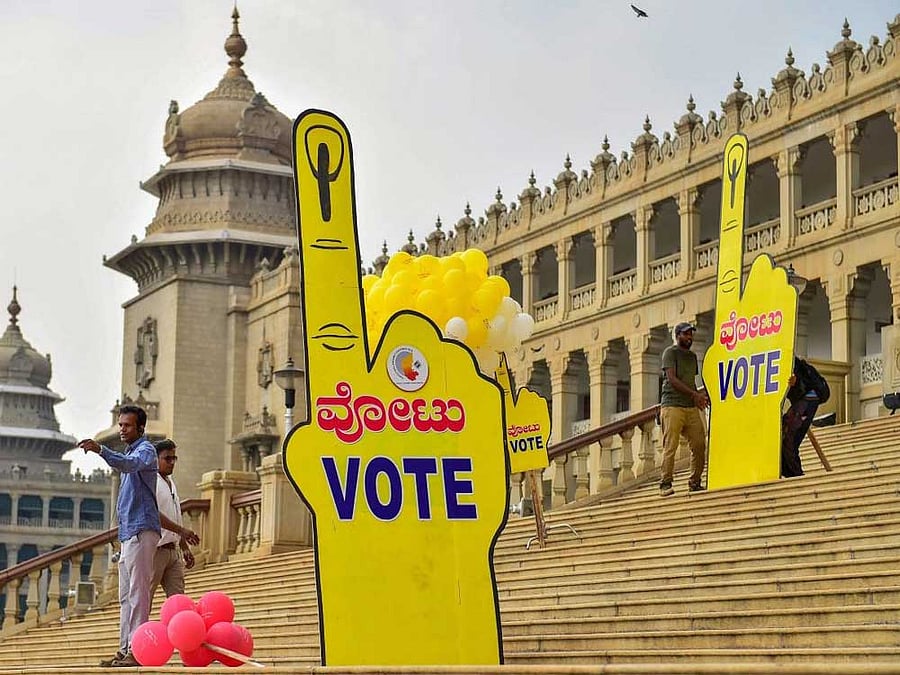Apathy has to do with whether or not the citizens believe that their voice matters. Urbanites have generally voted in lesser numbers than the rural folk in almost all the districts of Karnataka. There seems to be a historical lack of enthusiasm for voting in Bengaluru in the hustings. The low voter turnout in Bengaluru in the recent elections have been in spite of a high voltage campaigning.
In the 2009 parliamentary elections, for example, the average voter turnout was just 45% in Bengaluru. Low and unequal turnout is a serious problem in any democracy. Voters in the cities tend to be more transient and easily distracted even to register to vote. There seems to be the absence of the customary evidence of political allegiance by the urbanites in Bengaluru. Voter apathy can also be indicative of the larger malaise in the political system.
The question that needs to be raised is why is urban apathy there, and what will it take to make the urban middle-class realise the privilege and importance of voting. Indifference to participation in the electoral process poses serious challenges and dilemmas.
Karnataka has 70 urban and 154 rural constituencies. Almost half of them (28) are in Bengaluru district. Urban turnout in the IT capital — 55% — is a poor show. The lowest voter turnout in the recent elections was in Dasarahalli and C V Raman Nagar with 48.03% and 48.98%, respectively. The highest recorded voter turnout was in Hoskote (Bangalore Rural) with 89.97%.
There can be a variety of reasons for voter apathy: cynicism about the politician and the political system is a major factor. Many urbanites do not vote because they feel that elections do not necessarily offer a chance for change. However, abstaining from the elections can only make matters worse.
High voter apathy in many cases can also be attributed to the personality and calibre of the candidates. In Karnataka, unlike in some other states, high levels of political violence or voter fatigue cannot be extended as a reason for keeping the voters away on election day.
In Bengaluru, some reported cases of duplication in the electoral rolls was a matter of concern. Duplication and deletion in the electoral rolls have also contributed to this sense of despondency. Many civil activists claim that the problem has less to do with apathy and more to do with the fact that many voters find that their names are mysteriously left out of the electoral rolls. They also raise the issue of some bogus voters whose names figure in the rolls. In this sense, the voter apathy is a reflection of the extent to which the electoral rolls are considered credible.
Apathy has also to do with the irregular voter registration. Intra-state and inter-state migrations account for low voter turnout on election day as many of them go to their hometowns to exercise their franchise. It is necessary to ensure a continuous voter registration process so that voters need not necessarily have to go back to where they are registered as voters.
The tragedy is when there are high levels of voter apathy in spite of a good weather and low levels of political violence. The culture of getaways in the weekends in Bengaluru has also taken its toll on the voter turnout. High levels of voter apathy can erode checks and balances, accountability and rule of law.
Even in the 2013 Karnataka Assembly elections, the apathy was reflected in the 55.81% voter turnout. Voter apathy is not necessarily a Bengaluru phenomenon, yet it cannot be justified. Technically, one would expect the most informed and educated populace to vote, but it does not necessarily happen that way. Often, the most informed and educated turn out to be the most indifferent. The problem of lower voter turnout is not easy to fix.
Voter apathy has been a running theme in many developed countries, too, especially in the US elections. In the US presidential elections since 1980, voter turnout has hovered between 48% and 57%. It also depends on the type of elections. For example, voter turnout has been much less in the mid-term elections. Part of the problem in the US is that voters have to register separately, and many Americans do not do this. US voter turnout is very low compared to other western democracies like France, where it tops 80%.
Failure to vote in Australia is punishable with a fine of A$20. In countries like Austria, Australia and Belgium, the voter turnout often touches almost 90%. In the US, compared to a likely winning candidate, the apathy is higher when the candidate is likely to lose. Many voters feel politically alienated, and hence, abstain from voting as a form of protest.
Impact on policy
Increased electoral competition may not necessarily and significantly increase voter turnout, especially in the urban areas. The recent Karnataka elections are a clear case in this regard. Technically when almost 50% of the population remains at home on election day – we end up getting a system of unequal representation.
Lower voter turnout has significant political and policy consequences. One option could be to identify mobilisation strategies and public policies that can help increase voter turnout. In India, compulsory voting has been off-limits. Hence, social capital and community participation are necessary pre-requisites for greater participation.
Arend Lijphart, a well known political scientist, considered voter apathy as “democracy’s unresolved dilemma.” This dilemma needs to be addressed to improve the representativeness of the electorate. Voter apathy will not disappear overnight. The time has come to rejuvenate citizens’ participation in the electoral process. An active and vibrant electorate is a necessary sine qua non for a healthy democracy. One way to rekindle participation in the electoral process is by ensuring that elections become part of one’s identity and consciousness. Perhaps, the time has come to carry out advocacy on voter’s education among the urbanites of Bengaluru.
(The writer is professor and Dean (Arts), Dept of Political Science, Bangalore University)
